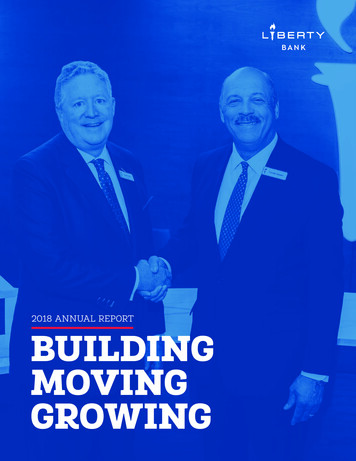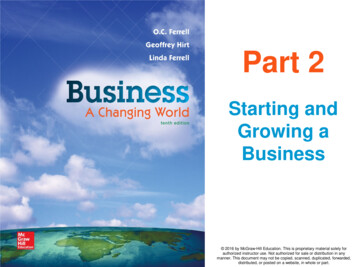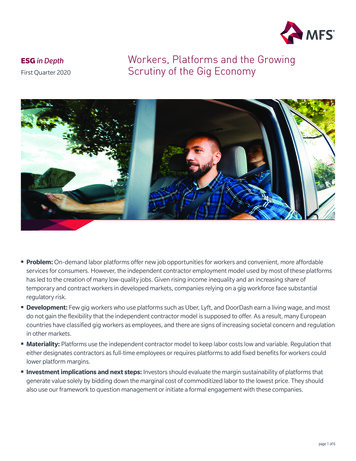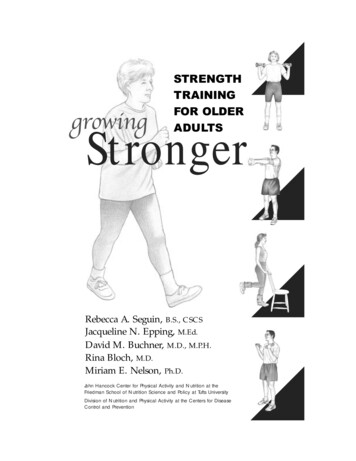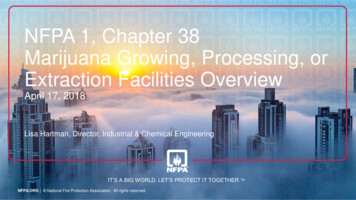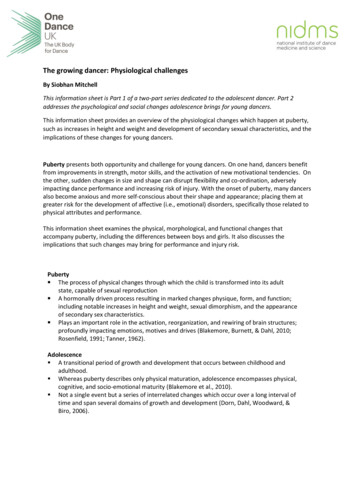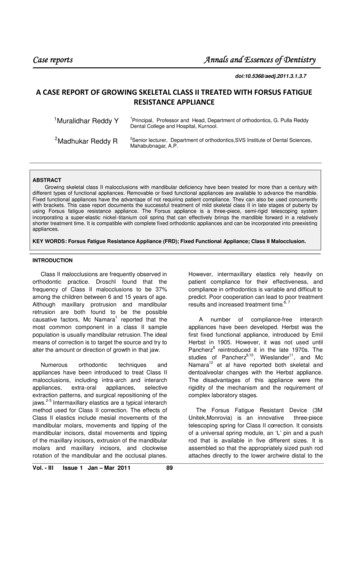
Transcription
Case reportsAnnals and Essences of Dentistrydoi:10.5368/aedj.2011.3.1.3.7A CASE REPORT OF GROWING SKELETAL CLASS II TREATED WITH FORSUS FATIGUERESISTANCE APPLIANCE1Muralidhar Reddy Y2Madhukar Reddy R1Principal, Professor and Head, Department of orthodontics, G. Pulla ReddyDental College and Hospital, Kurnool.2Senior lecturer, Department of orthodontics,SVS Institute of Dental Sciences,Mahabubnagar, A.P.ABSTRACTGrowing skeletal class II malocclusions with mandibular deficiency have been treated for more than a century withdifferent types of functional appliances. Removable or fixed functional appliances are available to advance the mandible.Fixed functional appliances have the advantage of not requiring patient compliance. They can also be used concurrentlywith brackets. This case report documents the successful treatment of mild skeletal class II in late stages of puberty byusing Forsus fatigue resistance appliance. The Forsus appliance is a three-piece, semi-rigid telescoping systemincorporating a super-elastic nickel -titanium coil spring that can effectively brings the mandible forward in a relativelyshorter treatment time. It is compatible with complete fixed orthodontic appliances and can be incorporated into preexistingappliances.KEY WORDS: Forsus Fatigue Resistance Appliance (FRD); Fixed Functional Appliance; Class II Malocclusion.INTRODUCTIONClass II malocclusions are frequently observed inorthodontic practice. Droschl found that thefrequency of Class II malocclusions to be 37%among the children between 6 and 15 years of age.Although maxillary protrusion and mandibularretrusion are both found to be the possible1causative factors, Mc Namara reported that themost common component in a class II samplepopulation is usually mandibular retrusion. The idealmeans of correction is to target the source and try toalter the amount or direction of growth in that jaw.Numerousorthodontictechniquesandappliances have been introduced to treat Class IImalocclusions, including intra-arch and extraction patterns, and surgical repositioning of the2- 5jaws. Intermaxillary elastics are a typical interarchmethod used for Class II correction. The effects ofClass II elastics include mesial movements of themandibular molars, movements and tipping of themandibular incisors, distal movements and tippingof the maxillary incisors, extrusion of the mandibularmolars and maxillary incisors, and clockwiserotation of the mandibular and the occlusal planes.Vol. - IIIIssue 1 Jan – Mar 201189However, intermaxillary elastics rely heavily onpatient compliance for their effectiveness, andcompliance in orthodontics is variable and difficult topredict. Poor cooperation can lead to poor treatment6, 7results and increased treatment time.A number of compliance-free interarchappliances have been developed. Herbst was thefirst fixed functional appliance, introduced by EmilHerbst in 1905. However, it was not used until8Pancherz reintroduced it in the late 1970s. The9,1011studies of Pancherz , Wieslander , and Mc12Namara et al have reported both skeletal anddentoalveolar changes with the Herbst appliance.The disadvantages of this appliance were therigidity of the mechanism and the requirement ofcomplex laboratory stages.The Forsus Fatigue Resistant Device (3MUnitek,Monrovia) is an innovativethree-piecetelescoping spring for Class II correction. It consistsof a universal spring module, an ‘L’ pin and a pushrod that is available in five different sizes. It isassembled so that the appropriately sized push rodattaches directly to the lower archwire distal to the
Case reportsAnnals and Essences of DentistryFig.1. Pre treatment Extra oral and Intra oral photographscanine teeth, and the spring to the headgear tube13via the ‘L’ pin. This is a case report demonstratingthe usefulness of Forsus Fatigue Resistant Device(FRD) in a skeletal class II patient reported duringthe late stages of puberty.Case reportA female patient of age 13 years came to theDepartment of Orthodontics with the chief complaintof forward placement of the upper front teeth. Shehad a square, symmetrical face with decreasedlower anterior facial height with competent lips. Aconvex profile with posterior divergence, normalnasolabial angle and deep mentolabial sulcus wasnoted. She had class II molar relationship on rightside and end on left side, an overjet of 10 mm andthe overbite of 5 mm, with the maxillary midlinecoincident with the facial midline and the mandibularmidline1 mm to the right of the facial centreline. MildVol. - IIIIssue 1 Jan – Mar 201190spacing in the upper arch and mild crowding in thelower arch was recorded(Fig.1). The Cephalometricanalysis revealed a skeletal class II relationship0(ANB 6 ) because of mandibular retrusion (SNA0081 ; SNB 75 ). The mandibular plane angles000(GoGn-SN 17 , FMA 14 ), Y-axis (56 ) and lowerfacial height (50%) were indicating of hypodivergentface.The patient was diagnosed as Angle’s class IIdivision 1 malocclusion on skeletal class II jawbases due to mandibular retrusion having hypodivergent growth pattern with deep overbite. Thegoal of orthodontic treatment was to reduce theoverjet and overbite, and correct the molarrelationship to Class I on both sides, using a nonextraction approach. It was decided that bilateralForsus Fatigue Resistant Device would provide themechanics necessary to achieve our aims.
Case reportsAnnals and Essences of DentistryDiscussionClass II malocclusion presents a major and14,15common challenge to orthodontists. Variousorthodontic techniques and appliances have beenintroduced to treat Class II malocclusions, includingremovable and fixed appliances, extra-oralappliances, selective extraction patterns, andsurgical option. To determine the best class IIdevice for a particular patient, the orthodontist mustconsider the factors as whether the patient profile isflat, concave, or convex; whether the face is long orshort; whether the incisors are flared upright;whether the maxilla is prognathic or mandibleretrognathic. The severity of problem and theanticipated patient co-operation also play animportant role.The case reported in this article is a youngfemale patient at the late stage of the puberty withskeletal class II malocclusion due to mandibularretrusion. It has been shown that fixed functionalappliances enhance mandibular growth and thatthey tend to produce a more horizontal condylargrowth compared with removable functionalappliances. The case was treated with fixedfunctional appliance using Forsus fatigue resistanceappliance. FDR typically demonstrate mesialmovement of the mandibular molars, tipping of themandibular incisors, and variable effects associated16,17with mandibular growth.The post treatmentresults showed significant improvement in the facial0profile (ANB 3 ) and class I molar relationship withideal overjet and overbite(Fig 4).Fig.2. Forsus Fatigue Resistant Device in placeTreatment progressOrthodontic treatment was started with 0.022"X 0.028" Preadjusted Edgewise System (RothMinitwin). An initial 0.014-inch round nickel titaniumarchwire was used for leveling and alignment of’’both arches for 4 weeks followed by 0.016 NiTIwire for one month. Two months later, upper andiiiilower wires were replaced with 0.016 X 0.022 NiTiIIand 0.017 X 0.025 stainless steel wires. TheForsus Fatigue Resistant Device was placed oniiboth sides when the arch wires were on 0.019 Xii0.025 SS for a period of 6 months (Fig.2). Theappliance was inserted from the distal part of thehead gear tube on the maxillary molar to the archwire distal to mandibular canine. Finishing anddetailing followed for 2 months after themolarcorrection. The active treatment was 12 months(Fig3). Lower fixed canine to canine and upperremovable retainer were given for retention.Vol. - IIIIssue 1 Jan – Mar 201191Fig3. Superimposition of pre and post treatmentlateral cephalametric tracings
Case reportsAnnals and Essences of DentistryFig.4. Post treatment Extra oral and Intra oral photographsCONCLUSIONA case of moderate skeletal class II on dentalclass II division 1 treated with preadjusted edgewiseappliance supplemented with Forsus FatigueResistant Device is reported. The Forsus FRD canbe used instead of class II elastics in mild casesand instead of Herbst appliances in severe cases.Forsus functional appliance work best in patientswith convex profiles, but they are indicated in anyclass II patients except those with normal mandiblesand protrusive maxillae, or with protrusive or overlylarge mandibles relative to other cranial structures.References1.Mc Namara JA. Components of Class IImalocclusion in children 8–10 years of age.AngleOrthod.1981;51:177–202.2. Graber TM, Rakosi T, Petrovic A. DentofacialOrthopedics with Functional Appliances. StLouis,Mo:Mosby;1997:346–352.Vol. - IIIIssue 1 Jan – Mar 2011923. Nelson C, Harkness M, Herbison P.Mandibular changes during functional appliancetreatment. Am J Orthod Dentofacial 5)81005-44.PatelHP,MoseleyHC,NoarJH.Cephalometric determinants of successfulfunctional appliance therapy. Angle Orthod.2002;72:410–417.PMid:124010495. Kulbersh VP, Berger JL,et al. Treatmenteffects of the mandibular anterior usion. Am J Orthod Dentofacial id:126379016. Gianelly AA, Arena SA et al. A comparison ofClass II treatment changes noted with the lightwire, edgewise, and Frankel appliances. Am )90137-4
Case reportsAnnals and Essences of Dentistry7. Nelson B, Hansen K, et al. Class II correctionin patients treated with class II elastics andwith fixed functional appliances: a comparativestudy. Am J Orthod Dentofacial 489PMid:109359548. Pancherz H. The Herbst appliance—itsbiologic effects and clinical use. Am J OrthodDentofacialOrthop1985;87:1–20.9. Pancherz H. Treatment of Class IImalocclusions by jumping the bite with theHerbstappliance:acephalometricinvestigation. Am J Orthod Dentofacial Orthop.1979;76:423–441.10. Pancherz H. The mechanism of Class IIcorrection in Herbst appliance treatment: acephalometric investigation. Am J OrthodDentofacialOrthop.1982;82:104–113.11. Wieslander L. Long-term effect oftreatment with the headgear-Herbst appliancein the early mixed dentition. Am J 1016/S0889-5406(05)81328-912. Mc Namara JA, Howe RP, Dischinger TG. Acomparison of the Herbst and Frankelappliances in the treatment of Class IImalocclusion. Am J Orthod Dentofacial 70007-Y13. William Vogt. The forsus fatigue . Bishara SE,Ziajia RR. Functionalappliances. A review. Am J Orthod DentofacialOrthop.1993;104:319–328.15. Shen G, Hagg U, Darendeliler M. Skeletaleffects of bite jumping therapy on themandible—removable vs. fixed functionalappliances. Orthod Craniofac Res PMid:15667639Vol. - IIIIssue 1 Jan – Mar 20119316. Carlos FM, Michael PM. Soft Tissue Changeswith Fixed Functional Appliances in Class IIdivision 1 A Systematic Review. Angle Orthod2006;76:712–720.17. Angela PR, Benjamin JG. Breakages using aunilateral fixed functional appliance: a casereport using The ForsusTM Fatigue /146531207225021852PMid:17347290Corresponding AuthorDr. Madhukar Reddy R MDSSenior lecturerDepartment of orthodonticsSVS Institute of Dental SciencesMahabubnagar,Andhra PradseshMobile:09704364411E mail: mrachalaortho@yahoo.co.in
X 0.028" Preadjusted Edgewise System (Roth Minitwin). An initial 0.014-inch round nickel titanium archwire was used for leveling and alignment of both arches for 4 weeks followed by 0.016’’ NiTI wire for one month. Two months later, upper and lower wires were replaced with 0.016ii X 0.

